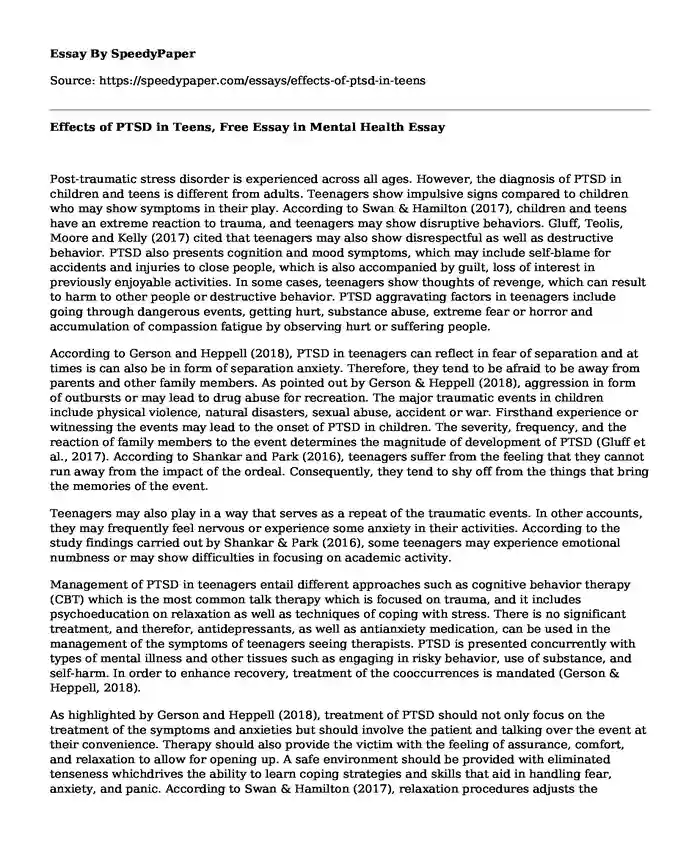
| Type of paper: | Essay |
| Categories: | Child development Post traumatic stress disorder |
| Pages: | 3 |
| Wordcount: | 729 words |
Post-traumatic stress disorder is experienced across all ages. However, the diagnosis of PTSD in children and teens is different from adults. Teenagers show impulsive signs compared to children who may show symptoms in their play. According to Swan & Hamilton (2017), children and teens have an extreme reaction to trauma, and teenagers may show disruptive behaviors. Gluff, Teolis, Moore and Kelly (2017) cited that teenagers may also show disrespectful as well as destructive behavior. PTSD also presents cognition and mood symptoms, which may include self-blame for accidents and injuries to close people, which is also accompanied by guilt, loss of interest in previously enjoyable activities. In some cases, teenagers show thoughts of revenge, which can result to harm to other people or destructive behavior. PTSD aggravating factors in teenagers include going through dangerous events, getting hurt, substance abuse, extreme fear or horror and accumulation of compassion fatigue by observing hurt or suffering people.
According to Gerson and Heppell (2018), PTSD in teenagers can reflect in fear of separation and at times is can also be in form of separation anxiety. Therefore, they tend to be afraid to be away from parents and other family members. As pointed out by Gerson & Heppell (2018), aggression in form of outbursts or may lead to drug abuse for recreation. The major traumatic events in children include physical violence, natural disasters, sexual abuse, accident or war. Firsthand experience or witnessing the events may lead to the onset of PTSD in children. The severity, frequency, and the reaction of family members to the event determines the magnitude of development of PTSD (Gluff et al., 2017). According to Shankar and Park (2016), teenagers suffer from the feeling that they cannot run away from the impact of the ordeal. Consequently, they tend to shy off from the things that bring the memories of the event.
Teenagers may also play in a way that serves as a repeat of the traumatic events. In other accounts, they may frequently feel nervous or experience some anxiety in their activities. According to the study findings carried out by Shankar & Park (2016), some teenagers may experience emotional numbness or may show difficulties in focusing on academic activity.
Management of PTSD in teenagers entail different approaches such as cognitive behavior therapy (CBT) which is the most common talk therapy which is focused on trauma, and it includes psychoeducation on relaxation as well as techniques of coping with stress. There is no significant treatment, and therefor, antidepressants, as well as antianxiety medication, can be used in the management of the symptoms of teenagers seeing therapists. PTSD is presented concurrently with types of mental illness and other tissues such as engaging in risky behavior, use of substance, and self-harm. In order to enhance recovery, treatment of the cooccurrences is mandated (Gerson & Heppell, 2018).
As highlighted by Gerson and Heppell (2018), treatment of PTSD should not only focus on the treatment of the symptoms and anxieties but should involve the patient and talking over the event at their convenience. Therapy should also provide the victim with the feeling of assurance, comfort, and relaxation to allow for opening up. A safe environment should be provided with eliminated tenseness whichdrives the ability to learn coping strategies and skills that aid in handling fear, anxiety, and panic. According to Swan & Hamilton (2017), relaxation procedures adjusts the response to stress, support group, and group therapies. However, the most significant treatment approaches in teens include Trauma-focused CBT, Behavioral dialectical therapy, and cognitive processing therapy.
In conclusion, PTSD in teenagers shows various effects which include an increase in risk-taking behavior, focusing and thinking difficulties, the decline in academic performance and isolation which reflect in difficulties in forming difficulties with peers and fear of trying near things and resistance to change. Management can be done through therapy and use of medicine which focus on the treatment of the related complications.
References
Gerson, R., & Heppell, P. (Eds.). (2018). Beyond PTSD: helping and healing teens exposed to trauma. American Psychiatric Pub.
Gluff, J. A., Teolis, M. G., Moore, A. A., & Kelly, D. R. (2017). Post-traumatic Stress Disorder (PTSD): A Webliography. Journal of Consumer Health on the Internet, 21(4), 389-401. https://doi.org/10.1080/15398285.2017.1377539
Shankar, N. L., & Park, C. L. (2016). Effects of stress on students' physical and mental health and academic success. International Journal of School & Educational Psychology, 4(1), 5-9. doi.org/10.1080/21683603.2016.1130532
Swan, J., & Hamilton, P. M. (2017). Posttraumatic Stress Disorder (PTSD).
Cite this page
Effects of PTSD in Teens, Free Essay in Mental Health. (2022, Feb 21). Retrieved from https://speedypaper.net/essays/effects-of-ptsd-in-teens
Request Removal
If you are the original author of this essay and no longer wish to have it published on the SpeedyPaper website, please click below to request its removal:
- Free Essay on Electronic Health Records Software
- HRM Essay Sample: The Moderating Role of Organizational Commitment
- Summary and Analysis of Earth Observatory, Space Essay Example
- Essay Sample: Psychological and Behavioral Factors of Individual Terrorists
- Free Essay: Human Intervention or Meddling in Ecosystem
- Essay Sample on Database, BI, the Internet, and Wireless Technology
- Augmented Space: A Transformative Art Medium for Autistics - Essay Sample
Popular categories




